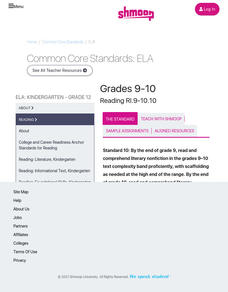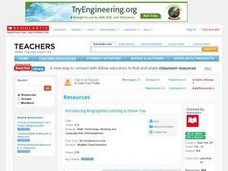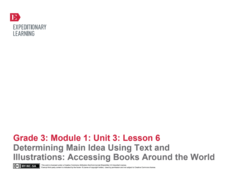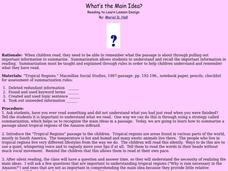American Press Institute
In the Newsroom: The Fairness Formula
Reporting the news is easy, right? Think again! Show young scholars the difficult choices journalists make every day through a lesson that includes reading, writing, and discussion elements. Individuals compare the language and sources...
Curated OER
Guided Reading "In the Night Sky"
Students participate in a variety of reading exercises, such as choral reading and reading response journal, to reinforce concepts about space and nocturnal animals.
Turabian Teacher Collaborative
Parts of Argument II: Article Critique
Break down the parts of argumentative writing with a critical thinking activity. High schoolers read an article of your (or their choice), and use a graphic organizer to delineate the ways the author structures his or her arguments.
EngageNY
Introduction: The Ideas of Charles Darwin
Piece by piece ... Scholars read the text World without Fish by breaking the text into pieces. They identify challenging words and determine the gist of each section as they read. They then work together in triads to answer...
ReadWriteThink
"Three Stones Back": Using Informational Text to Enhance Understanding of Ball Don't Lie
"Three Stones Back," a passage from Matt de la Pena's best-seller, Ball Don't Lie, allows readers to practice their close reading skills as they compare the passage to an information text about wealth inequality.
Curated OER
Irony in Poetry and Prose (Fiction and Non-fiction Texts)
Middle and high schoolers examine the impact of irony in poetry and prose. In this figurative language lesson, they read instructor-selected literature and identify uses of irony. Then they discuss how irony enhances literature.
EngageNY
Analyzing Text Structure: “The Shakespeare Shakedown”
Pupils continue reading and discussing Simon Schama's article "The Shakespeare Shakedown." They work together to analyze the article's paragraph structure, completing a note-catcher worksheet.
Shmoop
ELA.CCSS.ELA-Literacy.RI.9-10.10
Make sure that your pupils have mastered complex literary nonfiction by the end of the year and use this resource to help get them to that point. After a brief description of the Common Core standard, a list of age-appropriate...
Baruch College Writing Center
Summarizing, Paraphrasing, and Quoting Workshop
What's the difference between summarizing and paraphrasing? Show class members how to find the main ideas from informational text and condense it, restate it, or quote it directly with a series of educational activities based on two...
Washington Office of Superintendent of Public Instruction
Using Our Senses to Observe
Look around and explore. Little ones use their five senses with some day-to-day activities designed to guide observation and apply STEM strategies. Young scientists learn through comparing/contrasting and observing with magnifiers as...
Curated OER
Introducing Biographies-Getting to Know You
Students study biographies as a nonfiction genre while examining a variety of examples. Next, they access and complete an online tutorial about biographies. They choose one person that interests them to conduct further research using a...
Curated OER
Organizing Information into an Outline
Students explore outlines. In this nonfiction comprehension and study skills lesson, students complete a traditional outline for the book Animal Homes by Ann O. Squire following guided instruction as the teacher models gathering...
Scholastic
The Midnight Ride of Paul Revere
Practice sequencing events using Henry Wadsworth Longfellow's narrative poem about the famous revolutionary hero. Learners read Revere's own account of the event, and compare/contrast the two texts using a t-chart. Finally, they imagine...
EngageNY
Determining Main Idea Using Text and Illustrations: Accessing Books Around the World
Ease into informational text with the lesson suggested here. Part of a unit series, the lesson draws from previous lessons and acts as a natural moment to add in informational text. Class members read one section of My Librarian is a...
Curated OER
My Family
Young scholars read a story entitled, "My Family." They predict what they expect to they family will be doing in the book. Students explore strategies for decoding unfamiliar words. They brainstorm things family members might teach each...
Curated OER
Guided Reading with Hello Flower
Learners are introduced to the book and vocabulary through a group discussion. They view the book cover and predict what they expect the story to be about. Students read the book orally with the class. After a discussion, they whisper...
PBS
Copyright and Fair Use
When is using someone else's copyrighted material appropriate? Learn about copyright and fair use with a lesson from PBS.org. Scholars read through a reference sheet about authors' rights and users' rights, and then create posters for a...
Curated OER
Reading Through Rainforests
Students investigate the concept of the rainforest through the use of nonfiction texts. The teacher reads to the class to give some information. Then they read their own books to find further information and perform the follow activities...
Curated OER
Prereading
Fourth graders participate in think-pair-share reading strategy in this lesson. They identify their purpose for reading as well as purposes for reading fiction/nonfiction. They list and discuss several prereading activities, and then...
Curated OER
We Can Eat Smarter
Students practice their reading skills. In this reading comprehension lesson, students read an article titled "We Can Eat Smarter," and then use the reading strategy described to note confusing passages and revisit them.
Curated OER
1, 2, 3...A Summary
Students summarize a piece of nonfiction text. After reviewing the correct way to gather the important information needed to summarize, students independently read a nonfiction article. They write a summary paragraph using the process...
Curated OER
Let's be Star Summarizers
Third graders summarize a piece of nonfiction text. After reviewing the correct way to read for important information and summarize that information, students independently read a nonfiction article. They write a summary paragraph using...
Curated OER
What's the Main Idea?
Students summarize a piece of text. After reviewing the correct way to read and summarize, students work in groups to summarize a piece of text assigned by the instructor. They write a summary paragraph using the process outlined during...
Curated OER
Ask Questions About a Topic
Learners explore reading comprehension by completing a graphic organizer. For this journalism technique lesson, students discuss important questions they can ask about stories they read to improve comprehension. Learners identify...

























